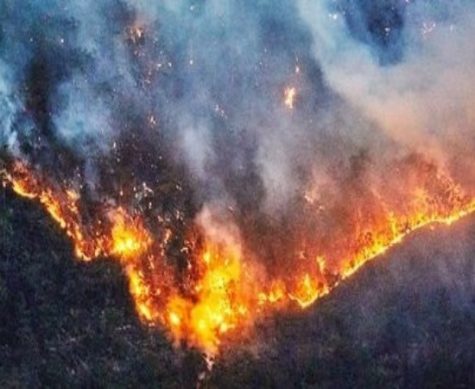Australian bush fires killing everything in their path
SYDNEY, AUSTRALIA – DECEMBER 19: Fire and Rescue personal run to move their truck as a bushfire burns next to a major road and homes on the outskirts of the town of Bilpin on December 19, 2019 in Sydney, Australia. NSW Premier Gladys Berejiklian has declared a state of emergency for the next seven days with ongoing dangerous fire conditions and almost 100 bushfires burning across the state. It’s the second state of emergency declared in NSW since the start of the bushfire season. (Photo by David Gray/Getty Images)
28 people. 1 billion animals. 15.6 million acres of land. These were the costs of the Australian fires as of the end of January.
In mid-July, the fire season in Australia began. As the fires grew, lightning and high speeds of wind helped the flames spread across the country.
According to The Washington Post, the Australian bush fires are considered a “political flashpoint.” They help show us that the fires are a vivid signal of the global crisis of climate change, which can make ecological conditions more suitable to the starting and intensification of the wildfires. Climate change has been a controversial topic in Australia for years, a wedge issue that has decided elections in the country.
Mst tragically impacted by the brush fires have been the animals of Australia. According to CNN 10, the government of New South Wales is throwing thousands of pounds of sweet potatoes and carrots out of helicopters to help save the endangered brush-tailed rock wallabies.

The government and citizens are doing everything that they can to save the precious wildlife that they have left. ABC 7 news writes, “On Kangaroo Island in Southern Australia, Micah Lovegrove was helping his uncle asses the damage to property due to the raging fires. The two quickly spotted an injured koala which they put safely in Micah’s car. Micah and his uncle decided to check his property for any more injured animals, they wound up finding a couple more koalas. They drove the koalas to his uncle’s neighbor’s house who have a permit for taking care of wildlife.”
These devastating fires have caused so much damage, New South Wales being the hardest-hit state per CNN10. And Australia’s fire season is only halfway over.
According to The Washington Post, “The flames have taken the lives of a dozen people in the past week, killed untold numbers of koalas and other animals, destroyed more than a thousand structures, forced tens of thousands of people to evacuate, choked cities with smoke. The smoke has reached the lower stratosphere and crossed 9,000 miles of ocean to pollute the skies of South America.”
Experts assert that if these fires were to keep going they would eventually ruin or pollute a major parts of the atmosphere for a very long time. It would also cause a lot more damage to Australian communities.

The smoke is very harmful to humans to breathe in, but in small amounts it is tolerable and according to CNN 10, the smoke is causing issues for residents and for the tennis players who are preparing for the Australian Open in Melbourne. There have also been reports of birds falling out of trees because they can’t handle the smoke in the capital, Canberra, Australia. These fires are not only damaging properties but the smoke that comes from them is hurting both wildlife and human life.
To add to that, The Washington Post writes, “The fires are so extreme that the weather bureau has warned of lightning strikes from what are called pyro-cumulonimbus clouds — fire-spawned thunderheads built of smoke, towering to 45,000 feet and generating ground-level convection that makes fire fighting harder.” This means that the smoke will build up and may help contribute to more fires starting and spreading.

The government is struggling to maintain adequate manpower to fight the blazes. According to The Washington Post, 3,000 army reservists were summoned by the government to assist with evacuations. People in remote areas are especially in need of assistance. But the chief firefighter in New South Wales, Shane Fitzsimmons, “complained Sunday that he didn’t know about the deployment until he saw the news on TV. He said he called the prime minister’s office for details.”
According CNN 10, there will be rainfall in the hardest-hit areas but there will not be enough to completely soak the states. This rainfall will help create relief in citizens and the fire department so that they could help with more evacuations. Even after all of the fire department and government’s hard work, during the day small fires are able to reignite due to the daily rise in temperature.
Across the globe, people are offering assistance. Eighth grade social studies teacher Mr. Catullo states, “The U.S. is starting to send aid to Australia like firefighters, money, and food. So I think that this is something really great that the world is contributing to send stuff to Australia, not only just for people but for the poor animals like kangaroos. I think that the world has done a good job responding by trying to help.”
The Australian Red Cross had raised $67 million dollars in donations as of late January. And a Facebook fundraiser for the New South Wales Rural Fire Service raised $34 million, the largest amount ever raised on that platform according to The New York Times.
Despite funds and support pouring in, nothing can stop the fires until the dry season ends. They are expected to continue for the next two months, at least, according to The Guardian: “the below-average rainfall means no relief from the drought, and not enough to put out or prevent fires.”

These devastating fires have caused a lot of damage in Australia to wildlife and human life. Volunteers and the government are contributing to making it to the end of the fire season, which is only halfway over.
It will be hard to repair all of the damages that the fires have caused to Australia–its economy, its people, and its wildlife.











